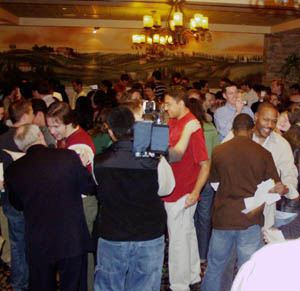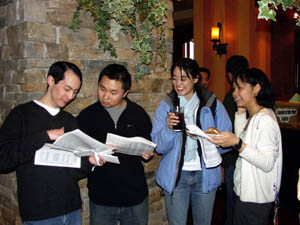Feinberg School Seniors Meet Their Matches
 This year’s Match Day coincided with St. Patrick’s Day, so fourth-year students at the Feinberg School of Medicine had double the reason to celebrate. Match Day is the culmination of the National Resident Matching Program (NRMP), a process that uses a computer algorithm to match the preferences of applicants with the preferences of residency programs to fill the available training positions at United States teaching hospitals. More than 200 people gathered at a restaurant near campus, including students, friends, family, and faculty and staff members from the Office of Student Programs and Professional Development and Office of Medical Education and Faculty Development. This year 161 of the 176 students in the Class of 2005 participated in the Match.
This year’s Match Day coincided with St. Patrick’s Day, so fourth-year students at the Feinberg School of Medicine had double the reason to celebrate. Match Day is the culmination of the National Resident Matching Program (NRMP), a process that uses a computer algorithm to match the preferences of applicants with the preferences of residency programs to fill the available training positions at United States teaching hospitals. More than 200 people gathered at a restaurant near campus, including students, friends, family, and faculty and staff members from the Office of Student Programs and Professional Development and Office of Medical Education and Faculty Development. This year 161 of the 176 students in the Class of 2005 participated in the Match.
Angela Nuzzarello, MD, MHPE, associate dean for student programs and professional development, served as master of ceremonies to direct the distribution of the Match envelopes to students for the traditional countdown and simultaneous opening. Also attending and helping out was Jack F. Snarr, PhD ’67, the retired student programs dean who presided over 29 previous Match Days.
Nationally the number of residency positions offered and filled set records: 24,012 positions were available, and 22,221 were filled. Seventy-eight percent of all applicants matched to a first-year residency program. Nearly 83 percent of all matched applicants were paired with one of their top three residency program choices. Fourth-year students from U.S. medical schools enjoyed a higher success rate than other  applicants, with 93.7 percent matching and more than 86 percent of those students assigned to one of their top three choices.
applicants, with 93.7 percent matching and more than 86 percent of those students assigned to one of their top three choices.
Choices made by U.S. medical school seniors indicate first-year residency positions in dermatology, emergency medicine, general surgery, orthopaedic surgery, and plastic surgery remain highly competitive. At least 95 percent of the available positions in these specialties were filled, and more than 80 percent of these were taken by U.S. medical school seniors. First-year family medicine positions available through the Match continue to decline (from 3,183 in 2000 to 2,761 in 2005), as does U.S. medical school seniors’ interest in these positions, which decreased for the eighth consecutive year. However, interest in psychiatry is rising. For the fourth consecutive year, the number of first-year positions offered and filled by U.S. medical school seniors went up. The largest specialty in the Match, internal medicine, represents one-fifth of all residency positions offered, and slightly more than half of its first-year positions were filled by U.S. medical school seniors.






